Photos
If you would like to see a full-size version of any photo, click on it, then use your browser's back button to return to this page.
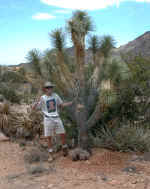
|
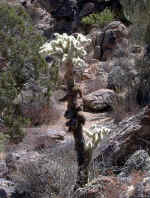 |
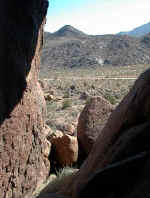
|
| Another Joshua tree, rescued from destruction by bulldozer and moved to the garden | The teddy bear cholla (Opuntia bigelovii) defends itself with a formidable array of straw-colored spines that look soft enough to pet. Resist the temptation | A view across D:FR from inside the arch on the ridge above the property |
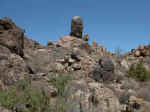
|
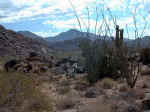
|
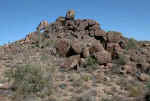 |
| Standing rocks on the ridge above D:FR | Looking to the east from the D:FR ridge. The leafless stick-like plants are ocotillos (Fouquieria splendens). They are not dead, merely drought-dormant. When the rains return, they leaf out within 48 hours | Another balanced rock up on the ridge, not too far from the arch |
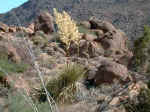
|
 |
|
| Cousin to the yuccas and agaves, a large Bigelow nolina (Nolina bigelovii) inhabits the rocky slopes of D:FR. The flower spikes are about 10 feet tall | Nursery-grown plants in 15-gallon pots waiting to be planted at D:FR. Included in this view are organ pipe cacti (Stenocereus thurberi), senita (Lophocereus schottii), and Argentine giant Easter lily cactus (Trichocereus species) | The rocky ridgeline at D:FR above the main garden areas. We plan to have an access road run through the central area in the foreground back towards the ridge, where most of the buildings will be constructed |
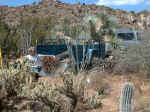
|
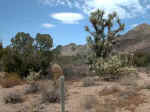
|
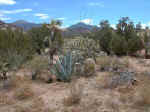
|
| Moving and planting another large Joshua tree. To date, about 200 trees have been salvaged and planted at D:FR. How many of these will survive is still unknown... | Another planting bed in the garden has begun. The small plant resembling a young saguaro cactus is actually a cardon, which is a similar columnar cactus from the Sonoran Desert in Baja California and Sonora, Mexico. Behind the cardon (Pachycereus pringlei) is a very large red barrel cactus, about four feet tall | A large Mexican blue agave (Agave americana) anchors a new planting bed at the garden. Also known as century plants for their habit of blooming only once in their lives and then dying (although none actually take 100 years to bloom, more like 10 to 40 years). This is one of the species that tequila is distilled from |
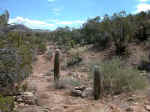 |
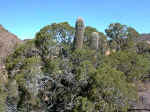 |
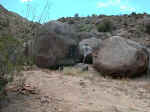
|
| Two juvenile saguaro cacti (Carnegiea gigantea), the smaller about 4 feet and the larger about 7 feet in height. Their ages are most likely about 40 years for the smaller one and 65 to 70 years for the taller. The lack of annual growth rings in cacti makes it hard to age them exactly, unlike trees with real wood. Age also depends upon rainfall -- the more rain, the more growth. These two are probably older than similar-sized plants growing near Tucson, Arizona, for example, which receives about 12 inches of annual rainfall compared with about 8 inches at D:FR | A rare sight. This saguaro cactus is using a juniper tree (Juniperus monosperma) as a nurse plant. The ranges of these two species seldom overlap. A "nurse plant" is any tree or shrub that helps young seedling cacti grow to maturity by providing protection from browsing rodents, blistering sun, and winter frosts. Cactus seedlings cannot, by and large, survive their vulnerable first years of life without the benefit of nurse plants or their counterparts, nurse rocks | Jan Emming, general manager of D:FR, views the future construction site. A home and other buildings are planned for this and other nearby rock outcrops. The structures will be placed in and amongst the boulders, using the stones as roof supports and walls. For the best existing example of this unusual sort of architecture, click on this link: www.boulderhousepublishers.com |
 |
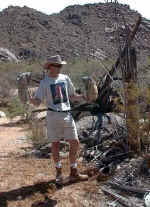 |
More photos (page 2) |
| A saguaro skeleton. This particular specimen is about 15 feet long, with nice branches at the top. Note that the skeleton is a hollow cylinder of conjoined woody ribs, not unlike the rib cage of vertebrates in some regards. The green water-storing flesh of the cactus lies both inside and outside of this hollow cylinder, and decays away rapidly once the cactus dies, leaving what you see here. This one will ultimately be incorporated into the main home as a decorative accent | Jan Emming holds up a "saguaro boot", the old and callused lining of a nest hole excavated by the Gila woodpecker in a saguaro trunk. To prevent water loss to the dry air and infection by disease-causing organisms, the cactus creates a tough, scab-like callus over the wound. Years later, when the cactus dies, the soft and fleshy parts of the plant decay away, leaving the hard parts such as these old nest cavities and the skeletal ribs that hold up the plant, which can be seen in the background to the right | |